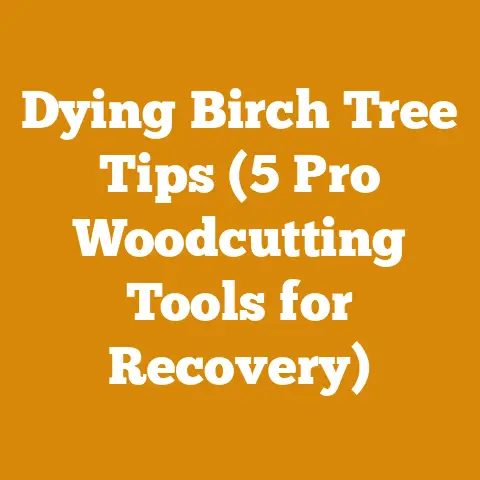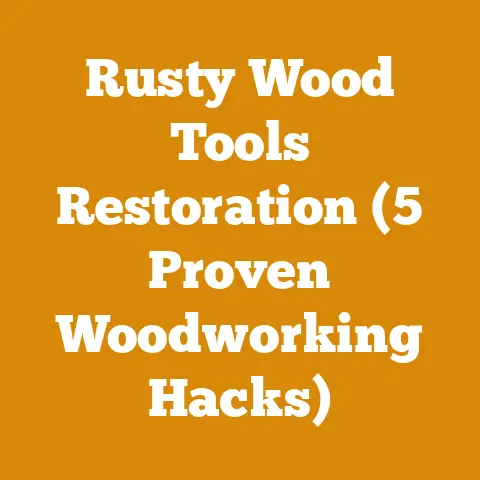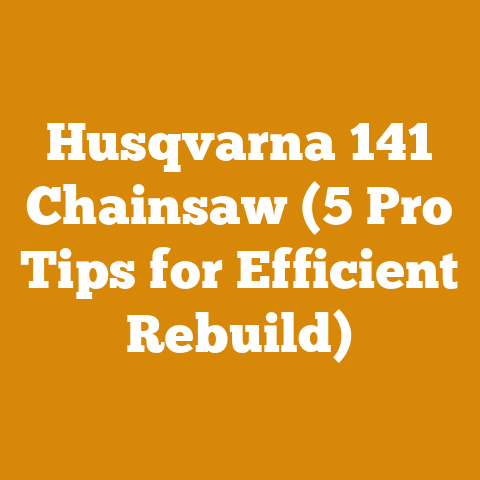Remove Stump with Chainsaw (5 Pro Tips for Clean Cuts)
As someone who’s spent countless hours in the woods, I understand the satisfaction of turning raw timber into something useful, whether it’s lumber for a project or firewood to keep my family warm. But sometimes, the job isn’t quite finished when the tree comes down. That stubborn stump remains, a testament to the tree’s former glory, and a potential tripping hazard in my yard. Over the years, I’ve tried various methods for dealing with these woody reminders, and I’ve found that using a chainsaw can be one of the most effective – and frankly, satisfying – ways to remove a stump, especially when done safely and with the right techniques.
Removing Stumps with a Chainsaw: 5 Pro Tips for Clean Cuts
Removing a tree stump is a task that demands respect, both for the power of the tools involved and for the potential hazards present. Before even thinking about firing up my chainsaw, I always prioritize safety and proper planning. This guide isn’t just about cutting wood; it’s about doing it smartly and safely.
1. Safety First: Gear Up and Assess the Situation
Before I even think about getting near a chainsaw, safety is my absolute top priority. I treat every stump removal as a potentially hazardous operation, and I prepare accordingly.
-
Personal Protective Equipment (PPE): This isn’t optional; it’s essential. I always wear the following:
- Chainsaw Chaps: These are designed to stop a chainsaw chain instantly, preventing severe leg injuries. Trust me, they’re worth every penny.
- Steel-Toed Boots: Protect your feet from dropped objects and chainsaw mishaps.
- Eye Protection: Safety glasses or a face shield are crucial to keep flying debris out of your eyes.
- Hearing Protection: Chainsaws are loud, and prolonged exposure can damage your hearing. Earplugs or earmuffs are a must.
- Gloves: Provide a better grip and protect your hands from cuts and splinters.
- Hard Hat: Especially important if there are overhead branches or potential falling debris.
-
Stump Inspection: Before I start cutting, I carefully inspect the stump and its surroundings:
- Hidden Obstacles: Look for rocks, roots, or metal objects embedded in the stump or ground. Hitting these with your chainsaw can damage the chain and potentially cause kickback, which can be incredibly dangerous. I often use a metal detector to be extra cautious.
- Underground Utilities: This is crucial! Call your local utility company to locate any underground lines before you start digging or cutting. Hitting a gas or electrical line can be catastrophic.
- Surrounding Area: Clear away any brush, debris, or tripping hazards around the stump. Make sure you have a clear and stable work area.
-
Chainsaw Inspection: A well-maintained chainsaw is a safer chainsaw.
- Chain Sharpness: A sharp chain cuts more efficiently and is less likely to kick back. I sharpen my chain regularly using a chainsaw file and guide.
- Chain Tension: Proper chain tension is essential for safe operation. The chain should be snug but still able to be pulled around the bar by hand.
- Bar and Chain Oiler: Make sure the oiler is working properly. A dry chain creates excessive friction and can lead to premature wear and increased risk of kickback.
- Safety Features: Check that the chain brake is functioning correctly. This is a critical safety feature that can stop the chain instantly in case of kickback.
Takeaway: Safety is paramount. Never compromise on PPE or skip the pre-work inspection. A few minutes of preparation can prevent serious accidents.
2. Choose the Right Chainsaw and Accessories
Using the right tool for the job makes all the difference. While a small chainsaw might be suitable for pruning branches, removing a stump requires a more robust and powerful tool.
- Chainsaw Size and Power: For most stump removal projects, I recommend a chainsaw with a bar length of at least 18 inches and an engine displacement of 50cc or higher. This provides sufficient power and reach to cut through larger stumps. If I am dealing with a particularly large stump, I’ll even opt for a saw with a 20-inch or 24-inch bar.
- Chainsaw Type: Both gas-powered and electric chainsaws can be used for stump removal, but I generally prefer gas-powered saws for their power and portability. Electric chainsaws are quieter and require less maintenance, but they may not be as powerful or have the same runtime.
- Chainsaw Chain: Use a chain designed for cutting dirty wood. These chains are more resistant to dulling when encountering dirt and debris. I often use a chain with carbide-tipped cutters, as they hold their edge longer when cutting through potentially contaminated wood.
- Digging Tools: A sturdy shovel, pickaxe, and mattock are essential for digging around the stump and exposing the roots. I also find a root saw or reciprocating saw with a long blade helpful for cutting smaller roots.
- Winch or Come-Along: For larger stumps, a winch or come-along can be invaluable for pulling the stump out of the ground after it’s been cut.
- High-Pressure Water Nozzle: I often use a high-pressure water nozzle attached to my garden hose to wash away dirt and debris from around the stump and roots. This helps to prevent dulling the chainsaw chain and reduces the risk of kickback.
Takeaway: Invest in quality tools that are appropriate for the task at hand. The right equipment will make the job easier, safer, and more efficient.
3. Excavate and Expose the Roots
Before I can start cutting the stump, I need to excavate around it to expose the roots. This is often the most physically demanding part of the process, but it’s essential for making clean and safe cuts.
- Digging Around the Stump: Using a shovel, I dig a circular trench around the stump, extending at least 1-2 feet out from the stump’s perimeter. The depth of the trench will depend on the size and depth of the roots, but I typically aim for a depth of at least 1 foot.
- Exposing the Roots: As I dig, I carefully expose the roots, using a pickaxe or mattock to loosen the soil around them. I try to avoid damaging the roots too much, as this can make them more difficult to cut.
- Cleaning the Roots: Once the roots are exposed, I use a high-pressure water nozzle to wash away any dirt and debris. This is crucial for preventing dulling the chainsaw chain and reducing the risk of kickback. I pay particular attention to cleaning the areas where I plan to make cuts.
- Cutting Smaller Roots: Smaller roots can be cut with a root saw or reciprocating saw. I try to cut these roots as close to the stump as possible to make the final removal easier.
- Dealing with Larger Roots: Larger roots will need to be cut with the chainsaw. Before cutting, I make sure the roots are properly supported to prevent them from pinching the chainsaw bar. I also use wedges to keep the cut open and prevent the bar from binding.
Personal Story: I remember one time I was removing a particularly large oak stump. I had dug down about two feet and was still encountering massive roots. I was getting frustrated and started cutting without properly cleaning the roots. On my third cut, the chain hit a hidden rock, causing a violent kickback that nearly threw me off balance. Luckily, I was wearing my safety gear and wasn’t injured, but it was a stark reminder of the importance of taking my time and following proper safety procedures.
Takeaway: Excavating and exposing the roots is a critical step in the stump removal process. Take your time, clean the roots thoroughly, and always prioritize safety.
4. Make Strategic Cuts with Precision
With the roots exposed and cleaned, I can now start making strategic cuts to remove the stump. This requires careful planning and precise execution to ensure a clean and safe removal.
- Planning the Cuts: Before I start cutting, I carefully plan the cuts I need to make. I aim to cut the stump into manageable pieces that I can easily remove. I also consider the direction of the wood grain and the location of any remaining roots.
- Making the First Cut: I start by making a vertical cut on one side of the stump, as close to the ground as possible. I use the chainsaw to cut through the stump, being careful to avoid pinching the bar. If the bar starts to bind, I use wedges to keep the cut open.
- Cutting Around the Stump: I continue making vertical cuts around the stump, gradually removing sections of wood. I try to make the cuts as even as possible to create a level surface.
- Cutting the Taproot: Once I’ve removed the majority of the stump, I’m left with the taproot, which is the main root that grows straight down into the ground. This can be the most challenging part of the removal process.
- Removing the Taproot: I carefully dig around the taproot to expose as much of it as possible. I then use the chainsaw to cut the taproot below ground level. If the taproot is too large to cut with the chainsaw, I may need to use a winch or come-along to pull it out of the ground.
- Cutting Large Roots: For large roots, I use a technique called “notching.” I make a series of angled cuts into the root, creating a notch. I then make a final cut to sever the root completely. This technique helps to prevent the root from splitting or splintering.
Takeaway: Strategic cutting is essential for safe and efficient stump removal. Plan your cuts carefully, use proper techniques, and always be aware of the potential for kickback.
5. Clean Up and Fill the Hole
Once the stump is removed, the job isn’t quite finished. I need to clean up the area and fill the hole to prevent tripping hazards and restore the landscape.
- Removing Debris: I start by removing all the debris from the area, including wood chips, roots, and soil. I use a shovel and wheelbarrow to transport the debris to a designated disposal area.
- Filling the Hole: I fill the hole with topsoil, compacting it in layers to prevent settling. I may also add compost or other organic matter to improve the soil quality.
- Grading the Area: Once the hole is filled, I grade the area to create a smooth and even surface. I use a rake to level the soil and remove any rocks or debris.
- Planting Grass or Other Ground Cover: Finally, I plant grass seed or other ground cover to restore the landscape. I water the area regularly to promote growth.
- Disposing of the Stump: I have several options for disposing of the stump. I can haul it to a landfill or recycling center, or I can cut it into smaller pieces and use it for firewood. I can also rent a stump grinder to grind the stump into mulch.
Takeaway: Cleaning up and filling the hole is an important final step in the stump removal process. This ensures a safe and aesthetically pleasing result.
Advanced Techniques and Considerations
While the above steps cover the basics of stump removal with a chainsaw, there are some advanced techniques and considerations that can make the job easier and more efficient.
Using a Stump Grinder
A stump grinder is a specialized machine designed to grind stumps into mulch. It consists of a rotating wheel with carbide-tipped teeth that chip away at the wood. Stump grinders are available for rent at most equipment rental centers.
-
Benefits of Using a Stump Grinder:
- Faster and more efficient than using a chainsaw.
- Can grind stumps below ground level.
- Produces mulch that can be used for landscaping.
-
Safety Considerations When Using a Stump Grinder:
- Wear appropriate PPE, including eye and hearing protection.
- Clear the area of any obstacles or debris.
- Keep bystanders at a safe distance.
- Follow the manufacturer’s instructions carefully.
Chemical Stump Removal
Chemical stump removal involves using herbicides to kill the stump and accelerate its decomposition. This method is slower than using a chainsaw or stump grinder, but it can be effective for removing stumps in hard-to-reach areas.
-
How Chemical Stump Removal Works:
- Drill holes into the stump.
- Pour herbicide into the holes.
- Cover the stump with a tarp to prevent rain from diluting the herbicide.
- Wait several months for the stump to decompose.
-
Safety Considerations When Using Herbicides:
- Wear appropriate PPE, including gloves and eye protection.
- Follow the manufacturer’s instructions carefully.
- Avoid contact with skin and eyes.
- Keep children and pets away from the treated area.
Dealing with Large Stumps
Removing large stumps can be a daunting task, but it can be accomplished with the right tools and techniques.
- Using a Winch or Come-Along: A winch or come-along can be used to pull large stumps out of the ground after they’ve been cut. Attach the winch or come-along to the stump and a nearby tree or anchor point. Slowly and steadily pull the stump out of the ground.
- Using a Backhoe or Excavator: For extremely large stumps, a backhoe or excavator may be necessary. These machines can provide the power and leverage needed to remove even the most stubborn stumps.
Takeaway: There are several advanced techniques and considerations that can make stump removal easier and more efficient. Choose the method that is best suited for your specific situation.
Troubleshooting Common Stump Removal Problems
Even with careful planning and execution, you may encounter problems during the stump removal process. Here are some common problems and how to troubleshoot them:
- Chainsaw Kickback: Kickback occurs when the tip of the chainsaw bar contacts an object, causing the saw to suddenly kick back towards the operator. To prevent kickback, always use a chainsaw with a chain brake and anti-kickback chain. Avoid cutting with the tip of the bar, and be aware of your surroundings.
- Chainsaw Bar Binding: The chainsaw bar can bind when the wood pinches the bar during cutting. To prevent binding, use wedges to keep the cut open. Also, make sure the chain is sharp and properly tensioned.
- Dull Chainsaw Chain: A dull chain will make cutting difficult and increase the risk of kickback. Sharpen the chain regularly using a chainsaw file and guide.
- Stump Won’t Budge: If the stump is too large or the roots are too deep, it may be difficult to remove. Try using a winch or come-along to pull the stump out of the ground. If that doesn’t work, you may need to rent a backhoe or excavator.
- Underground Utilities: Hitting an underground utility line can be dangerous and costly. Always call your local utility company to locate any underground lines before you start digging or cutting.
Takeaway: Stump removal can be challenging, but with proper planning and troubleshooting, you can overcome most obstacles.
Environmental Considerations
When removing stumps, it’s important to consider the environmental impact of your actions.
- Soil Erosion: Digging around stumps can disturb the soil and lead to erosion. Minimize soil disturbance by using hand tools whenever possible. Cover exposed soil with mulch or ground cover to prevent erosion.
- Habitat Destruction: Removing stumps can destroy habitat for wildlife. Avoid removing stumps during nesting season, and consider leaving some stumps in place to provide habitat for insects and other animals.
- Herbicide Use: Herbicides can be harmful to the environment if not used properly. Follow the manufacturer’s instructions carefully, and avoid using herbicides near water sources.
- Disposal of Debris: Dispose of wood chips, roots, and soil properly. Haul debris to a landfill or recycling center, or use it for landscaping. Avoid burning debris, as this can release harmful pollutants into the air.
Takeaway: Be mindful of the environmental impact of your stump removal activities, and take steps to minimize your impact.
Cost Analysis: DIY vs. Hiring a Professional
Deciding whether to tackle stump removal yourself or hire a professional depends on several factors, including the size and number of stumps, your experience level, and your budget.
-
DIY Stump Removal:
- Pros:
- Lower cost.
- Sense of accomplishment.
- Control over the process.
- Cons:
- Time-consuming.
- Physically demanding.
- Potential for injury.
- Requires specialized tools and equipment.
- Pros:
-
Hiring a Professional:
- Pros:
- Faster and more efficient.
- Less physically demanding.
- Reduced risk of injury.
- Access to specialized tools and equipment.
- Cons:
- Higher cost.
- Less control over the process.
- Pros:
-
Cost Comparison:
- DIY: The cost of DIY stump removal will depend on the tools and equipment you need to purchase or rent. A chainsaw can cost anywhere from \$200 to \$1000, while a stump grinder can cost \$100 to \$300 per day to rent.
- Professional: The cost of hiring a professional stump removal service will depend on the size and number of stumps, as well as the location and accessibility of the stumps. Stump removal services typically charge \$100 to \$400 per stump.
Takeaway: Weigh the pros and cons of DIY stump removal versus hiring a professional to determine the best option for your specific situation.
Safety Checklist for Stump Removal
Before starting any stump removal project, review this safety checklist to ensure you are prepared:
- Wear appropriate PPE, including chainsaw chaps, steel-toed boots, eye protection, hearing protection, gloves, and a hard hat.
- Inspect the stump and surrounding area for hidden obstacles, underground utilities, and tripping hazards.
- Ensure your chainsaw is in good working order, with a sharp chain, proper chain tension, and a functioning bar and chain oiler.
- Clear the area of any bystanders or pets.
- Establish a clear escape route in case of an emergency.
- Never work alone.
- Take frequent breaks to avoid fatigue.
- If you are unsure about any aspect of the stump removal process, consult with a professional.
Takeaway: Safety should always be your top priority when removing stumps. Follow this checklist to minimize the risk of injury.
Conclusion: A Job Well Done
Removing a stump with a chainsaw is a challenging but rewarding task. By following these pro tips and safety guidelines, you can safely and efficiently remove stumps from your property, restoring your landscape and preventing potential hazards. Remember to always prioritize safety, use the right tools and techniques, and consider the environmental impact of your actions. With a little planning and effort, you can achieve a clean and professional result.
Now, go forth and conquer those stumps! Just be sure to wear your safety gear and take your time. The satisfaction of a job well done, and a stump gone, is well worth the effort.






